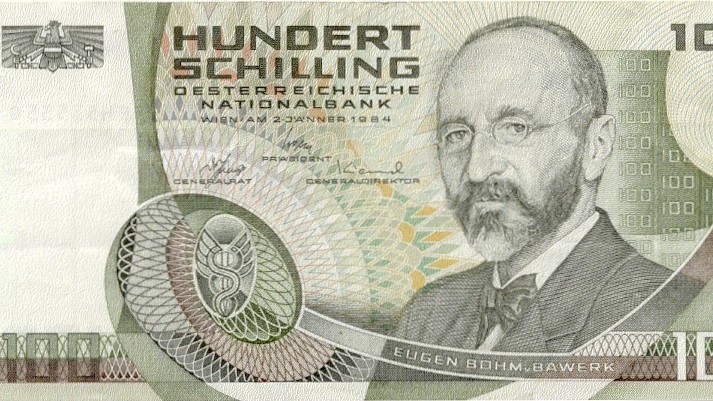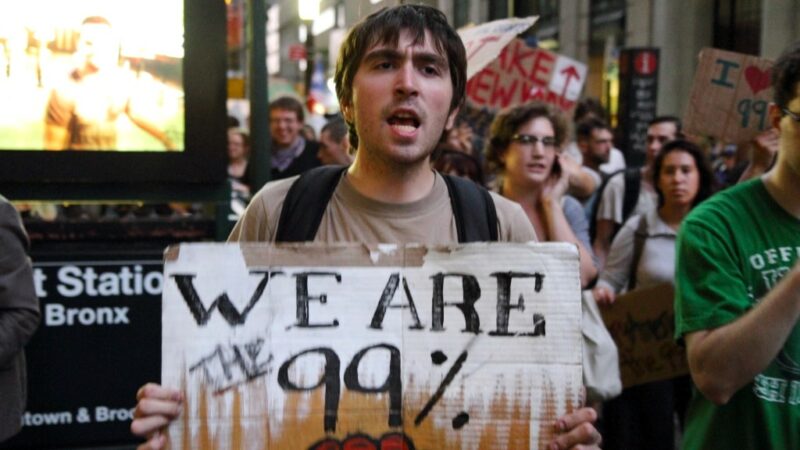 Eugen von Böhm-Bawerk (1851-1914), after Carl Menger the most important co-founder of the Austrian (or Viennese) School of Economics, shown here as Austrian Minister of Finance on the 100-shilling note of 1985. (Image: Wikimedia Commons)
Eugen von Böhm-Bawerk (1851-1914), after Carl Menger the most important co-founder of the Austrian (or Viennese) School of Economics, shown here as Austrian Minister of Finance on the 100-shilling note of 1985. (Image: Wikimedia Commons)
Economics is about exchange and not just scarcity, as is often written. Indeed, many things are also scarce, such as love, peace, and good politics. In an exchange, the two actors meet: the supplier and the demander. They come to an agreement, and the market is cleared—by consent, without violence. They also specialize—through a division of labor—and become more productive, exchanging, and acquiring something others can do better. Thus, the two actors have determined for themselves what is valuable and behave accordingly. They themselves determine the exchange value. One of the two definitions of justice is thus fulfilled—iustitia commutativa. The other justice—iustitia distributiva, “distributive justice,” which today is turned into mere redistribution at the expense of the more productive—is organized from the outside, from political and social policy, by taxation and redistribution beyond that. It is not a market, and it is not an economy (it is not even in itself more just or valuable).
Economic Value Is Always “Marginal Value”
But what are economic values? The early classical economists such as Adam Smith and later authors such as David Ricardo and Karl Marx, believed that the value of goods could be determined by the costs spent on their production (Smith) or the labor used for it (Ricardo, Marx). As a basis for calculation and planning, however, this idea fails. As soon as someone needs tools, the output of the labor increases—but how does one divide this between the labor previously put into the shovel and the shoveling itself? What about services that go into production? In short, the Austrian economist Ludwig von Mises saw this as impossible, and he predicted that planned economic systems would fail.
All participants in the market, all parties in an exchange, calculate. They consider their own benefit in the process, but in order for the other party to comply, they must also concede something for the other’s benefit.
In doing so, he relied on the Viennese economist Eugen von Böhm-Bawerk, who popularized the following explanation of marginal utility, originating from Carl Menger: Value is what the buyer is willing to pay, and this depends on the last unit still on offer. For a single offered bottle of water, the thirsty person pays a lot, for a bottle from a filled water tank that he notices, almost nothing. This is because he will wash his face with the second and third bottle, and this marginal benefit will determine the price of all bottles still filled from the water tank. If a company is desperate for workers to fill a large order, it will recruit them additionally with higher wages, but in time it will have to pay everyone at this rate. It can do this because the marginal utility of these new hires is high. But if it hires more and more workers, their marginal productivity falls, i.e., the additional effect of the new hires decreases per capita, and the firm’s profit falls. In short, these “marginalities” are what explain values, benefits, costs, compensation, profits in the market economy. They are fluid, not fixed values.
All participants in the market, all parties in an exchange, calculate. They consider their own benefit in the process, but in order for the other party to comply, they must also concede something for the other’s benefit. Only force, including economic force in the form of monopolies or cartels, can distort this—which is why they are banned and prosecuted (although the state itself often creates or supports the most harmful monopolies). Or if the state poisons the market with an overdose of rules, then another market seeps in through the cracks, leading to corruption, i.e., “monetary benefits” for buying the possibility of circumventing the state-created obstacles to free exchange.
The Market Creates Differences, Not Equality—And This Benefits Everyone
The result of market relations is “disparity”: some are successful, some are not. The only condition is that all market positions are contestable—whoever makes big profits, or whoever invented a valuable computer program, must always expect competition. To put it even more clearly, against belittlers and critics of all kinds: markets create differences, not equality. Otherwise, the participants would never know what is more successful, more productive, and more useful. Adam Smith’s “invisible hand” then has its guiding role. And the plural here, “markets,” is also important—the market economy consists of thousands of markets.
Oftentimes, market participants are mercilessly accused of pure self-interest, and their behavior is therefore condemned as that of a “homo economicus.” But for over seventy years, economic theory has been nuancing how it understands the “economic” side of these people with calculators in their heads. According to behavioral economics and game theory, many proponents of which have won noble prizes, the motives of barterers are also non-linear and stubborn. They fear losses more than they appreciate gains, they indulge in “bookkeeping” and do not part with a good, or a share, even if the market collapses; moreover, they are not all equally well-informed and they follow herd behavior. Anomalies also occur, such as that a luxury good is more likely to be bought the more expensive it is—even if it does not bring any greater benefit at all.
The Best Regulation: Discipline by the Market
Inferring macroeconomic trends from such individual behavior is difficult and controversial. Followers of the interwar economist John M. Keynes believe they can handle large aggregates—saving, investing, consuming, exporting, all controllable with more or less money supply, higher or lower interest rates, by stimulating demand with government spending. My articles on this blog have always doubted the credibility of these recipes and point emphatically to the failure of such policies and their consequences: uncontrollably growing public debt, a money glut for the purpose of buying up this debt, related misallocations of all kinds up to an extremely socially harmful concentration of wealth. The Austrian school of economics, on the other hand, takes into account the aforementioned individual behavior of market actors, emphasizes the importance of the supply of goods and its constant expansion, not eternally stimulated demand. Additionally, it emphasizes good and, above all, fewer labor market rules and a free path for innovative firms, unrestrained by rules or profit skimming. Instead, it prefers that firms be sanctioned and disciplined in case of failure by allowing failure, even bankruptcies (“creative destruction”).
Statistics provide information about what is happening in the national economy, or at the firm level it is the balance sheet. Many commentators neglect such facts. However, such facts can often put an end to all the whitewashing and assertions. They are made accessible for laymen and as Walter Krämer humorously says, “In this way one lies with statistics” or at least with “interpreting statistics.”
Thinking instead of Fantasizing—Factual Arguments instead of Morally Heated Debates
Nobel Laureate Daniel Kahnemann has shown how such facts are sorted in the mind and lead to cognition. In a first surge one sees facts with emotion, spontaneously (“system 1”), but then one presses these facts through the filter of previous experiences, knowledge, and makes comparisons (“system 2”). Everybody who talks about economics can check himself in this way whether he is fantasizing or already thinking. Concerning endless debates and exchanges of examples the philosopher Karl Popper finally gives the verdict: As soon as a series of examples or even a theory is opposed by one single fact, they are wrong and have to be developed further.
Now, a methodological remark on highly morally charged discussions in economics or social policy: everyone should admit that they start from the same ethical standards, those who want more redistribution and those who want to reduce it. Instead of immediately suspecting the dissenter of being immoral, the alternative would promote a factual discussion about the appropriateness of the different concepts being applied.
Money is the “common medium” in the exchange between goods and services. In the past, it had its own material value (gold and silver)—i.e., it was itself an economic good equivalent to other material assets and the products of human labor—but for the last hundred years the central banks and the commercial banks have been manufacturing it “out of nothing” (FIAT-money = money by decree, unbacked paper money). Without disciplined money creation, however, all the speculations cursed by critics appear: Price bubbles, credit pyramids—public and private—and in the end Voltaire will be proven right once again: “Paper money always returns to its intrinsic value, to zero.”
Zero-Sum Thinking, “Robinsonades” and Other Fallacies
One has to run far away from certain pseudo-economic views. There is zero-sum thinking: many think that if one person gains, another has to lose. If profits rise, the working person suffers. If the wage share in the economy rises, the companies are ruined. If one wins on the stock market, he plunders others. If one works longer, or in overtime, he takes the work away from another—wrong (what about the women who work—do they take the work away from the men…?) But even here the processes are not linear, but dynamic. Values are created and increased: there is value creation (or so we hope).
Others explain economic processes in terms of nature and biology: “the money cycle is like blood circulation,” or “trees do not grow to the sky.” Maybe, but let us stick with statistics and social processes, which are always a network of human actions.
Very roughly, social aspects are violated in “Robinsonades”—one illustrates how Robinson Crusoe invested in a fishing net, how he made his companion Friday work. Nonsense, even if this thought experiment originating from Böhm-Bawerk is helpful for analyzing basic economic relationships, one cannot understand an economy with it, because that was an island, there were no markets, no acts of exchange, no society.
Moreover, it takes some courage today to reject the fashionable neuro-psychological experiments. Students are shown winning, losing, sharing money—and electrodes in the head are supposed to clarify where the fear, the greed, the altruism is located. Total nonsense, as Felix Hasler expresses very well (“Neuromythologie”). Again, the conclusions of such professors are all too bold, from assumed individual behavior to the overall economy. Society is more than a few students, often even the same ones over and over again, filling out questionnaires in an artificial environment and draining brain waves.
By contrast, I present a positive outlook—market and property are two organizational forms of society. A market is what it is, but property can be either private (“capitalistic”), a cooperative, or a partnership company like what John Lewis has in England with 80,000 “partners” who own the company. The condition is this: they all must exchange. They must read the desires of the market from the perspective of those with whom they exchange. Only in this way does it work, only in this way are the preferences of all sides in good hands, only in this way is there optimal prosperity without authorities—authorities who always think they know better, to the detriment of the general public.



